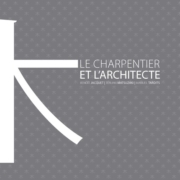Between Carpentry and Joinery Wood Finishing Work in European Medieval and Modern Architecture
P. Fraiture, P. Charruadas, P. Gautier, M. Piavaux, P. Sosnowska (eds.)
Brepols, 2017
From the examination of the historiography of finishing work in wood for architecture from the medieval to modern period, it is clear that this field of research is the poor relation of historical and archaeological studies, with the lion’s share focusing on the structural work of carpentry. It is on the basis of this observation that the present work has been produced, which results from a conference held in Brussels in 2013. The work demonstrates first the real interest in an approach to finishing work for the study of ancient buildings and the establishment of a precise chronology for their phases of layout as well as in obtaining better understanding of material cultures and ways of living. Second, it reiterates that the limit between carpentry and joinery was often porous, sometimes artificial. Finally, the work stresses that an overall approach to the use of wood is crucial to comprehensively address the organisation of a building, the logic of its construction and its ‘utilisation’, and more generally, the complex history of the buildings studied. This work, which thus represents a first step toward an overall approach of ‘wood material’ in European architecture, includes thirteen contributions divided into two thematic sections in keeping with current research practices. The first addresses the divide between structural and finishing work via the question of flooring, ceiling and roofing techniques. The second focuses intrinsically on finishing work by examining the contribution of this craft domain to the organisation, comfort and ornamentation of houses.
Table of Contents
Contents
Introduction: Wood finishing work, a promising area of research?
Paulo Charruadas, Pascale Fraiture, Patrice Gautier, Mathieu Piavaux, Philippe Sosnowska
Part I: Between carpentry and joinery: Constructing flooring, ceilings and roofing
Constructing ceilings: The floors of the Rhone region in the south of France at the end of the Middle Ages
Émilien Bouticourt
Structural timber in 15th- and 16th-century town houses in ’s-Hertogenbosch (The Netherlands): Recent research on supporting structures
Maarten W. Enderman
Ceilings and floorings in Austria: Types, dating and wood species
Michael Grabner, Andrea Klein, Sebastian Nemestothy, Erwin Salzger
Contribution to the history of Brussels floorings, Belgium (16th-19th centuries): Initial results of an archaeological and dendrochronological investigation Philippe Sosnowska, Pascale Fraiture, Sarah Crémer Panelled frames, modes of use: A technological and typological study of several roof frames in the Hainaut (Belgium)
Jean-Louis Vanden Eynde
Wood shingles of medieval roofs: A first approach in France
Pierre Mille
Part II: Organising light and space: Doors, windows, stairs and panelling
Wooden witnesses: Romanesque joinery and other wooden elements or their negatives divulging historical secrets of the St Martin’s Church, Zaventem (Belgium)
Karin Keutgens, Bernard Delmotte, Charles Indekeu
Wooden nailed doors in western France: An Armorican model inherited from the Middle Ages?
Vincent Bernard, Bruno Béthencourt, Yannick Le Digol, David Nicolas-Mery, Pierre Mille
Analyses of wooden front doors in rural buildings from Austria
Sebastian Nemestothy, Andrea Klein, Michael Grabner
The watertight integrity of window sills in western France: A
simple system with a complex development history
Arnaud Tiercelin
Window frame inventory number 3079 in the collections of the Royal Museums of Art and History, Brussels (Belgium): Results of archaeological, historical and dendrochronological studies
Patrice Gautier, Pascale Fraiture, Valérie Montens
Grand staircase and joinery work on the Lange Vijverberg, The
Hague (The Netherlands) in light of documents
Ada de Wit
Indoor joinery and furniture made for 18th-century houses in Liège (Belgium)
Isabelle Gilles






 PPUR
PPUR 
